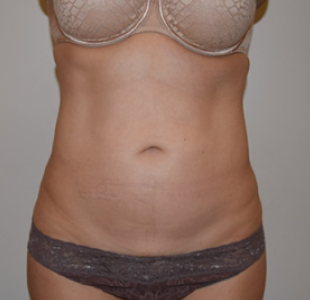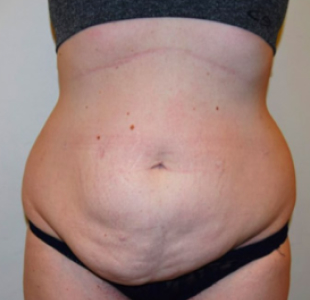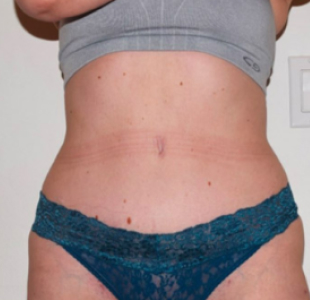Tummy Tuck
There are two common body changes people experience that often negatively impact the abdominal area: pregnancy and weight loss. Both these physical experiences can leave the individual with loose, excess skin, stubborn belly fat, and even damaged abdominal muscles.
Rapaport Plastic Surgery always strives to offer the best minimally invasive options for your cosmetic needs. But while noninvasive liposuction alternatives like CoolSculpting® may be effective, noninvasive alternatives for abdominoplasty simply do not measure up. A tummy tuck is irrefutably the most effective solution for loose abdominal skin and muscles after weight loss or pregnancy. With Dr. Rapaport’s expert approach, patients can enjoy the dramatic results of this procedure with the least possible scarring.
Learn More About Tummy Tuck
Patients most often consider abdominoplasty when they find themselves with a mixture of abdominal fat and loose skin, creating a sagging appearance and “belly pooch.” Most abdominoplasty candidates have unwanted changes in their abdomen due to pregnancy or weight loss. For some, removing excess fat will offer substantial improvement. Younger individuals typically have excellent elasticity, and the skin can be expected to “bounce back” following liposuction or CoolSculpting®, which lends to an ideal overall result.
Depending on skin elasticity, however, removing fat alone may not adequately improve the overall appearance of the abdomen. Factors such as previous pregnancies, significant fluctuations in weight, age, history of smoking, and genetics can all contribute to diminished skin elasticity. Unfortunately, non-invasive skin tightening techniques – including Ultherapy and Thermage – are inadequate to achieve meaningful tightening of lower abdominal skin. Dr. Rapaport does not recommend these procedures. Any patient with significant skin laxity will most likely need a tummy tuck instead of or in addition to fat reduction.
Abdominoplasty and Smoking
When one smokes cigarettes, there is a disturbance in the blood flow within the skin. This abnormal blood flow can lead to major complications in surgeries where the skin is significantly manipulated, such as an abdominoplasty. These complications include skin necrosis, which means the skin does not survive, and the patient subsequently experiences an open wound and poor scarring.
It is for this reason that Dr. Rapaport will not perform an abdominoplasty on people who are actively smoking. We require that our abdominoplasty patients stop all smoking for a minimum of six weeks to help reduce the risk of complications.
An abdominoplasty has two components. One is the skin and fat that occurs beneath the skin and above the abdominal wall muscles. We refer to this fat as “pinchable fat,” as opposed to the fat beneath the abdominal muscles. That fat, also called visceral fat, lies within the abdomen and is therefore not “pinchable.” The other component of some tummy tucks is the muscle, whose front portion you can feel with your fingertips when you pinch the skin and fat of your abdomen.
Patients may have a full or partial tummy tuck, depending on the amount of skin deemed necessary for removal, with or without muscle repair.
Repairing Abdominal Muscles During a Tummy Tuck
As part of normal anatomy, there is a fine line (linea alba) between the two vertical rectus muscles in the front of the abdomen. These are the muscles that create a six-pack when well-developed. The abdominal wall stretches as one of the natural changes that occur during pregnancy or major weight gain. In some people, the linea alba between the two muscles stretches and does not return to normal after childbirth or weight loss. This is called a diastasis recti.
The muscle edges are sutured together to repair diastasis recti during an abdominoplasty, thereby tucking in the loose abdominal wall. Sutures can also be placed at other portions of the abdominal wall to tighten further and shape the muscle.
A patient with abdominal muscle weakness or abdominal wall laxity may be a candidate for abdominal muscle tightening during the abdominoplasty procedure. While tightening the abdominal muscles during an abdominoplasty can provide substantial improvement for some of our patients, this can lead to some soreness during recovery.
In many patients, there is no real problem with the abdominal wall. For patients whose primary complaint is their loose skin and excess fat, there is no need to suture the muscles. An abdominoplasty that removes loose skin but does not tighten the underlying abdominal muscles is called a skin-only abdominoplasty.
Mini Tummy Tuck vs. Full Tummy Tuck
As discussed above, abdominoplasties can tighten skin alone or both skin and underlying abdominal muscles. The distinction between a “mini” and “full” abdominoplasty depends on how much loose skin needs to be removed.
The skin of the tummy area can be divided into that which is above the umbilicus (belly button) and below. The skin below the belly button is almost always part of the problem in women seeking abdominoplasty. At the time of consultation, we will determine to what extent the looseness of the skin above the belly button is a problem. More often than not, it is, especially in older patients. If it is indeed a problem, then the only way to tighten that skin is to place a scar around the umbilicus (belly button) so that the upper abdominal skin can be pulled down without lowering the umbilicus.
In cases when only skin below the umbilicus is loose, only that skin needs to be removed. Therefore, there would be no need for a scar around the umbilicus, and the lower abdominal scar may be shorter, depending on the amount of skin that needs to be removed. This is considered a mini tummy tuck. A typical case for a mini abdominoplasty may be a woman in her 30s who has had a c-section with loose skin of the lower abdomen, bulging out over the scar. In such a case, the lower abdominal muscles may or may not be repaired, depending on each case’s conditions.
In cases of loose skin above the umbilicus, a full abdominoplasty (with a scar around the belly button) will most likely be required to tighten the upper and lower abdominal skin. During the patient consultation, Dr. Rapaport will discuss whether or not to tighten the muscles in addition to the skin.
Abdominoplasty is often paired with other procedures, such as liposuction or breast augmentation, especially when it’s part of a mommy makeover. A complete tummy tuck surgery on its own normally takes approximately two to three hours to perform. A mini tummy tuck, on average, takes between one and two hours to perform. General anesthesia is typically utilized for abdominoplasty surgery, which Dr. Rapaport’s board-certified anesthesiologist will administer. Epidural anesthesia may be employed in selected cases.
Abdominoplasty Incision and Scarring
The scar from a full abdominoplasty must, by necessity, be long to remove the large area of skin. Dr. Rapaport frequently likens this scar to a hem on clothing; the hem has to cover the length of the area to be reduced. Dr. Rapaport has seen some extremely unfavorable results when less experienced surgeons have tried to achieve the results of a full tummy tuck with a short scar.
The amount of pulling in and crimping of the tissues, or excess skin on the sides (dog ears), can be very disturbing. It is important to differentiate between a long scar and a wide scar. In most cases, Dr. Rapaport’s abdominoplasty scars are narrow and fine because of his careful closure technique that keeps skin tension to an absolute minimum.
A tummy tuck surgery is a significant surgery. Because of the skin removal, it is crucial that the area of closure be kept under minimal tension for the first several days after the operation. This is why all abdominoplasty patients are instructed to walk bent over for the first five to seven days. You can return to light exercise, such as walking, after 10-12 days. More vigorous exercise resumes after four to six weeks, with approval from Dr. Rapaport.
All of Dr. Rapaport’s full abdominoplasty patients are required to stay overnight in NYC under the supervision of a nurse, both for patient safety as well as comfort. The nurse ensures that the patient rests properly (back elevated 30-40 degrees, legs bent with pillows under the knees). They also monitor blood pressure and discomfort and can medicate accordingly, as needed. The nurse monitors drainage (drains are almost always used) and instructs the patient on drain care for the days following their abdominoplasty in New York City.
Before the nurse’s departure on the morning after surgery, they will take photographs of the abdomen and send them to Dr. Rapaport to confirm good healing. Typically, between days five and seven following surgery, drainage is low enough for the patient to come into the office and have her or his drains removed. At this point, the patient can stand upright again.
The minimum downtime after abdominoplasty surgery is about ten days. If surgery is performed on a Friday, one can generally expect drains to be removed the following Thursday or so, and one may return to very non-active work ten days after surgery. However, it must be emphasized that even ten days after an abdominoplasty, all activity must be kept at a minimum to ensure proper healing and avoid complications. A patient from another city or country should plan to arrive in New York at least one full day (preferably two) before surgery and stay in New York for a minimum of 14 days following surgery.
Trained at Harvard and NYU and a board-certified plastic surgeon, Dr. David Rapaport combines his certified expertise and artistic vision to ensure outstanding results. His 25 years of experience performing body contouring procedures has placed him at the forefront of non-invasive body contouring and sculpting, making him a leader in the field.
A successful NYC tummy tuck surgery entails a delicate blend of aesthetics and technical precision, capturing the proper proportions to produce a natural-looking waist and attractive tummy contour. Dr. David Rapaport has made it his mission to wed the art to the science, and the results he’s achieved for his clients are a testament to his status as a renowned surgeon.
Patients can expect to appreciate the results of their tummy tuck in a few weeks as swelling and bruising subside. The procedure yields permanent results, though future pregnancy or weight fluctuations could undo the improvements.
Take the Next Step
Every patient’s transformation journey at Rapaport Plastic Surgery begins with a detailed consultation with Dr. Rapaport. To learn more about tummy tuck and determine if it’s the right choice for you, fill out the form below or call us at (212) 249-9955 to schedule an appointment. Our team is dedicated to providing the best plastic surgery NYC has to offer.
Ready to book a consultation or treatment? Just click the Book Now button below to schedule online.




